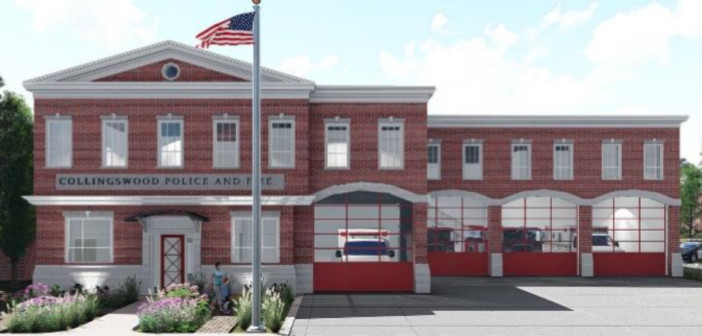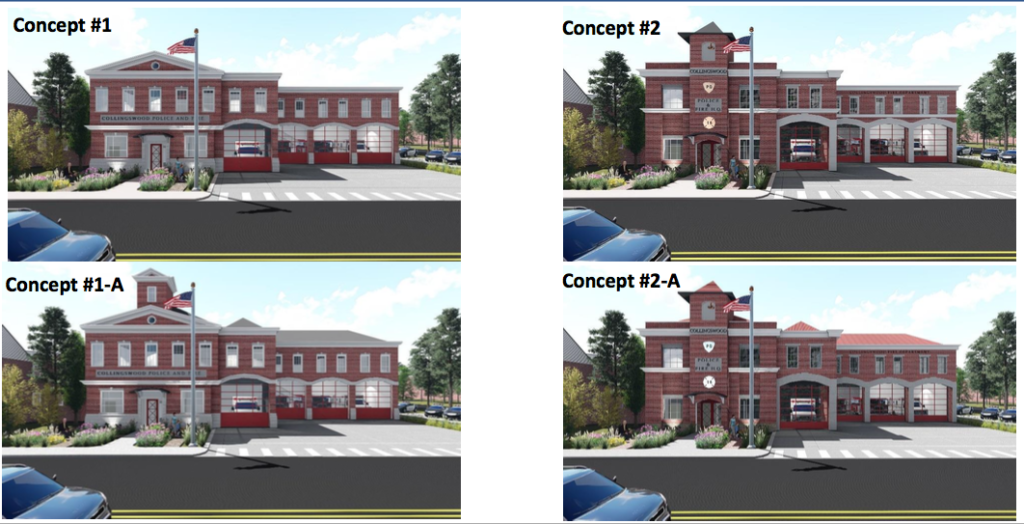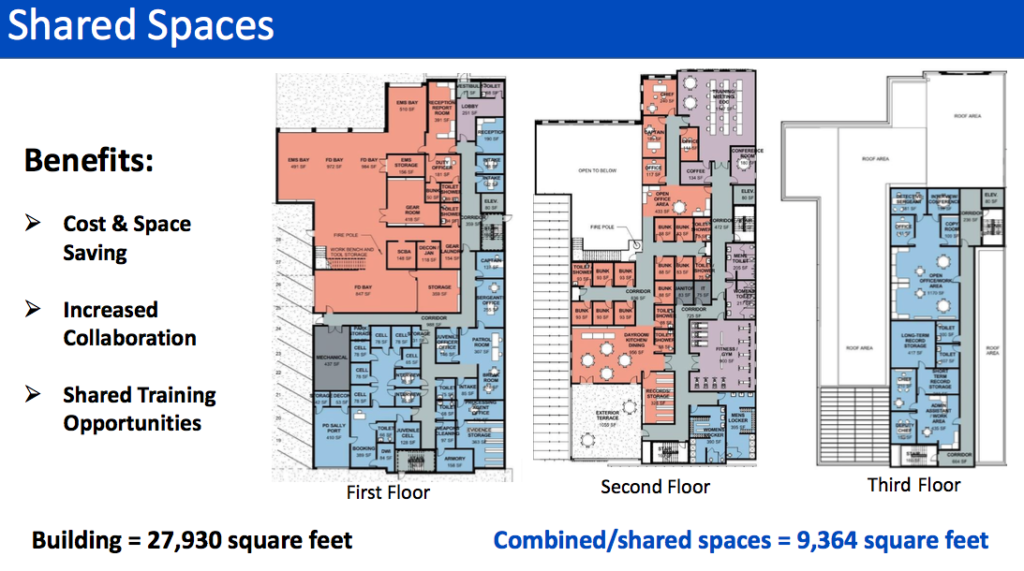Local leaders presented building designs to neighbors in the area around the 400 block of Haddon Avenue, seeking public comment on the look, layout, and use of the property.
By Matt Skoufalos | November 9, 2018
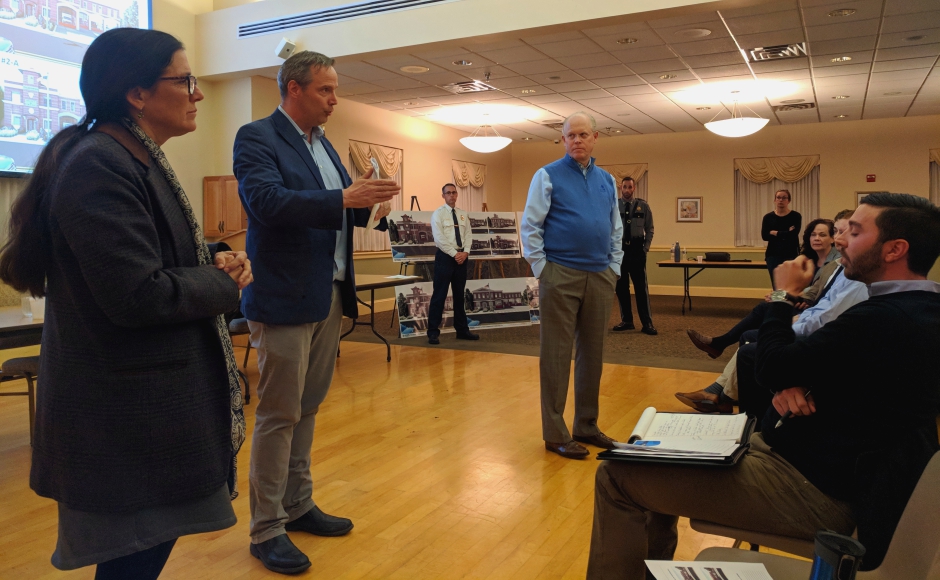
Collingswood commissioners discuss plans for the new public safety building. Credit: Matt Skoufalos.
For years, the Collingswood borough government has held a horizon goal of overhauling its public safety infrastructure.
Last year, police and fire officials outlined a number of deficiencies in their current facilities, which they said they’ve outgrown and retrofitted to the utmost.
That kicked off a process whereby the municipal government eventually acquired a property in the 400 block of Haddon Avenue on which to construct a joint police and fire building.
On Wednesday, borough commissioners publicly debuted a handful of designs for the facility before a group of neighbors.
The four concepts presented varied in architectural details, but all described a three-story, 28,000-square-foot building similar in materials to those used in the Lumberyard complex and the Old Zane School.
Its design centers on a Haddon Avenue frontage with a four-bay garage and public-facing main entrance with a combined reception area. The fire department would be situated towards the front of the building, with police operations in the rear.
The fire bays are set back about 50 feet from the main entrance of the building, allowing emergency personnel to pull the truck out without obstructing the walking path in front of it, said Collingswood Fire Chief Keith Davis.
Public access to the reception area would be limited to 8 a.m. to 4 p.m. with a one-hour closing from noon to 1 p.m. Unlike the current facilities, however, the new building would have a 24-7 reception vestibule for off-hours requests for service.
Among the changes for the police department is an expanded holding cell area with a secured “sally port” for prisoner reception, Collingswood Police Chief Kevin Carey said.
“You pull in, [and] once your vehicle is in the garage, the door goes down, and it’s locked,” Carey said. “Once it’s locked, you can have access into the building.”
The expanded holding cell area differentiates between juvenile and adult detainees—which the current Collingswood Police station does not—and is a “weapons-free, hardened space,” Carey said.
“There’s no way to get in and out of there without a keyfob,” Carey said.
Maley said the safety improvements of the new design are “a critical issue for the officers.”
The second floor of the building would include a shared conference center/training room and fitness facility, firefighters’ quarters and executive offices, police lockers, a dining facility and rooftop terrace.
The third story of the building, which is set back from the first two, contains the police chief’s quarters, long-term record storage, and conference rooms.
Environmental features include a planned wildlife habitat garden outside the main entrance, possible vegetative barriers to the surrounding property, and pervious concrete surfaces designed to help with stormwater management. A full site plan and survey are forthcoming as the evolution of concepts proceeds, officials said.
“Our every effort” is “to make it green,” said Collingswood Commissioner Joan Leonard.
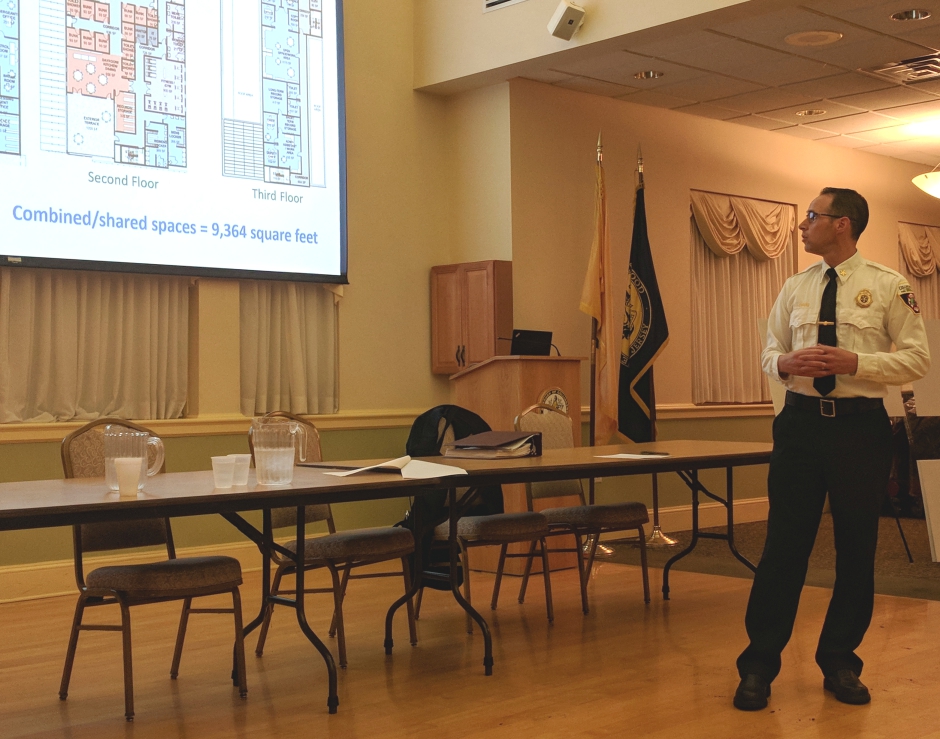
Collingswood Fire Chief Keith Davis describes plans for the new public safety building. Credit: Matt Skoufalos.
Some elevation concepts incorporated a possible bell tower, a design inspired by the historic Collingswood Fire Department structure.
The tower could contain a ceremonial bell, “never to ring,” Maley said to a roomful of neighbors concerned about the impact of the facility on their block.
The commissioners also alluded to potential expansion of the property to include unused green space owned by the neighboring Methodist home and paved parking lots belonging to adjacent physician practices.
“Nothing’s been agreed to, and it’s not including their buildings,” Maley said of the talks. “We’re only planning for the land that we own. To the extent that the other property becomes available, it could certainly be worked in with additional parking.”
The mayor repeatedly described the plans as conceptual, and the process as designed to be inclusive of neighbor comments. None of the designs presented have yet been drafted in conjunction with environmental and neighborhood impact studies, and the entire project must be approved by the local planning board when final studies are made.
“Part of this process is to keep you advised, but you also get to see how things aren’t set in stone as we go along,” Maley said. “Right now we’re trying to get a general idea. We’re trying to make it be pretty and fit in the neighborhood.”
For Haddon Avenue resident Emilia Carolfi, however, the entirety of the project is a neighborhood disruption.
“How’s this going to improve my quality of life?” Carolfi said. “My windows… they’re all going to face your bays. At night when you back up this apparatus, I’m going to be awakened. Every time.
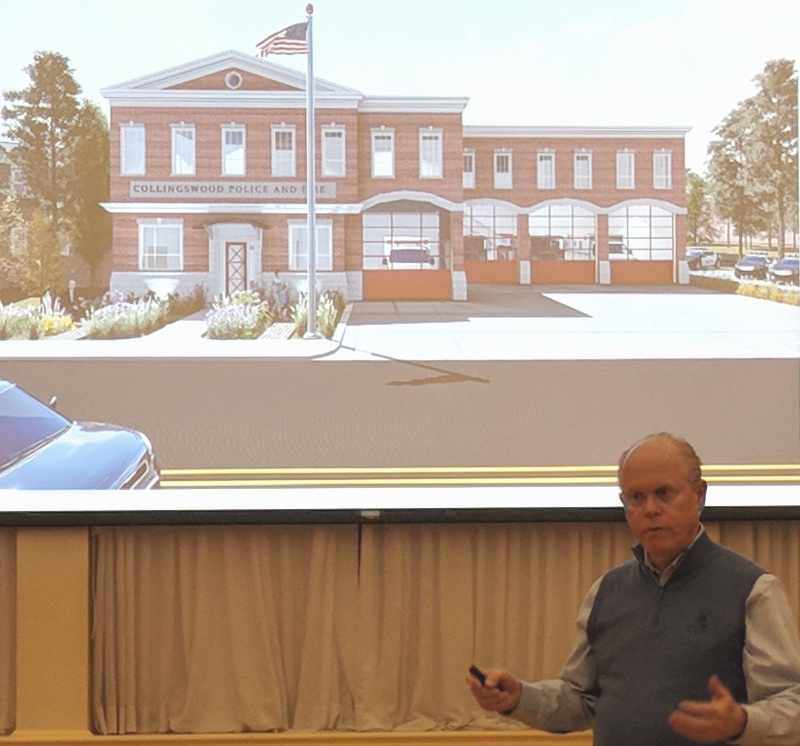
Jim Maley introduces designs for the new Collingswood public safety building. Credit: Matt Skoufalos.
“Right now my neighborhood is pretty quiet,” Carolfi said.
“I can’t fit it into my image of how I’m going to live my life.
“There’s going to be light pollution, there’s going to be noise, there’s going to be truck traffic, and I don’t know how I’m going to sleep.
“The whole facility in this location doesn’t really suit this residential neighborhood,” Carolfi said.
Other neighbors from the rear of the property, along West Summerfield Avenue, expressed concerns about stormwater management, the deteriorated condition of an existent retaining wall, and general concerns that their quiet community would be adversely affected by the change.
Maley countered that the governing body is “doing everything we can to minimize the impact” of the project on the surrounding neighborhood.
The borough fire department only operates two large vehicles, typically one at a time, and is busier during daylight hours than at night, Davis said. The chief said the department is looking for red interior lighting that would be muted for evening hours. He also said the department has updated its internal policies to limit noise and light pollution.
“If traffic warrants it, we can pull out without the lights and sirens on, which we don’t normally do anyway,” Davis said. “There’s not a need for us to use our backup lights.”
The fire chief added that only eight of 17 full-time, on-duty firefighters will be in the building at a given time. They work 24-hour shifts in staggered starts, and a shared office and inspection bureau with Pennsauken reduces foot and vehicle traffic to the facility.
Carey said his officers aren’t in the building between 7 and 8:30 a.m. and 2 and 3 p.m., when they work school traffic and security details. Those assignments similarly reduce the neighborhood impact of foot and vehicle traffic to the facility, as neither the police nor fire staff start their shifts at the same time, Davis said.
Maley also pointed to existent traffic on the block being difficult to reduce beyond a certain level.
“It’s Haddon Avenue,” he said. “It’s the number two busiest street in town.”

Collingswood commissioners discuss plans for the new public safety building. Credit: Matt Skoufalos.
In addition to the replacement of their current, crumbling, and retrofitted facilities, which police and fire officials have described as substandard, benefits of the merger could include closer integration of the borough emergency services personnel, shared training opportunities, and savings from creating 9,400 square-feet of shared space.
Carey said an upgraded police station would allow the department to apply for accreditation, which improves its professional standing and could reduce insurance liability.
Davis said the fire department upgrades could potentially lower local insurance costs.
The mayor said the borough government is working to minimize the financial impact of the project, for which he offered a “broad, ballpark” estimate of “maybe $10 million.”
Maley described the tax impact of the project as “minimal, if any,” citing anticipated revenue increases from the Parkview apartments PILOT agreement and the retirement of some municipal debt.
“We’d maintain debt at the level that we’re at, but it will be replacement debts,” he said.
“We’ve been working for 20 years to make this happen,” Leonard said. “Money is coming in where we can pay for this, which we’ve always wanted to do.”
Along a similarly rough estimate, the project could begin with a summer 2019 groundbreaking, and then proceed along a one-year timeline to completion.
Simultaneously, Maley said the borough is working on plans to relocate its Department of Public Works garage to a new facility on Route 130. Once those projects are completed, the existing police building and garage could be demolished (the fire house is privately owned by the local volunteer fire company), freeing up space behind Haddon Avenue for additional public-private redevelopment.
In prior conversations, the mayor has described horizon goals to relocate the borough government offices from their current location and into the community center, which would be expanded to incorporate a new courtroom and additional professional offices.
Those moves are farther off, however.
“We’re waiting to get this settled and on a path to spend some time working on what will be going on in that parking lot area,” Maley said.
The next public forum at which officials will discuss the public safety building will be held December 5.
NJ Pen is free thanks to regular, small contributions. Please support our work.
Get e-mails, follow us on Facebook, Twitter, and Instagram, or try Direct Dispatch, our new text service.

